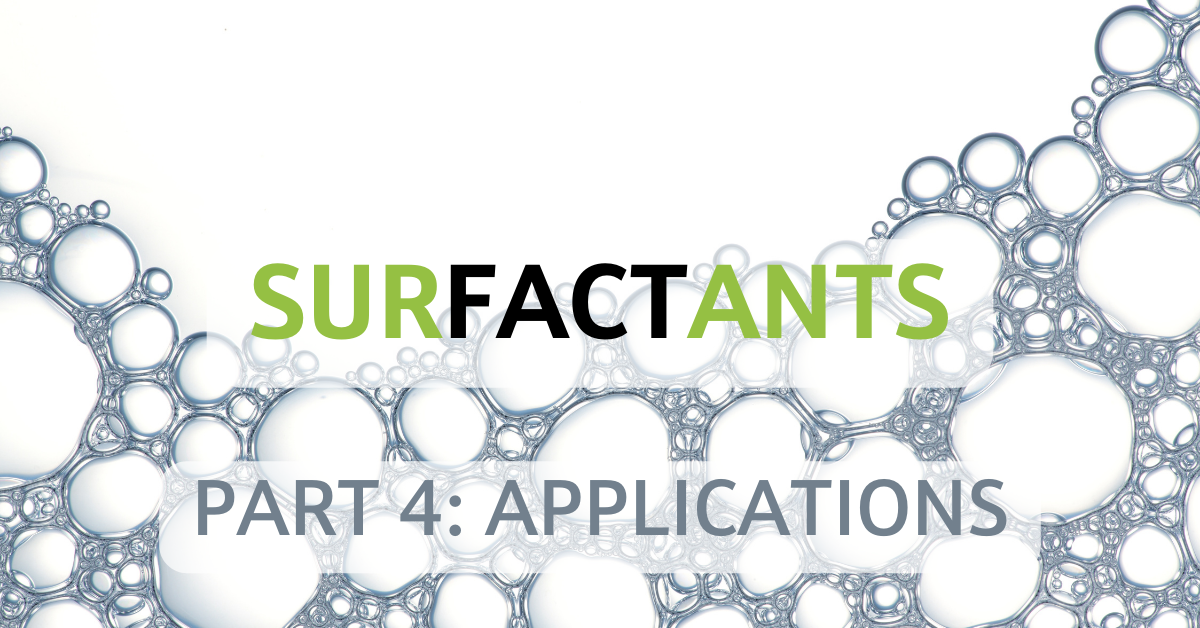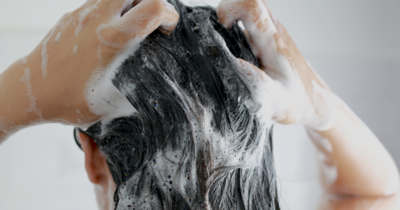
Putting the Fact in SurFACTants: Applications
Maximizing Efficiency in Top Surfactant Applications
Surfactants are unique molecules that are found in everyday life, from what we eat to how we clean. But not all surfactants have the same uses and applications. In fact, surfactants can be used in many different ways.
Top surfactant applications:
- Detergents
- Emulsifiers
- Wetting agents
- Multifunctional ingredients
Even though the most easily recognizable surfactants are those that work as detergents, there is more to their story than just the bubbly liquid dish soap in the kitchen sink or the foamy shampoo for hair.
Surfactants have a unique ability to emulsify (or mix) two immiscible (normally unmixable) liquids together, like oil and water. They can also act as wetting agents that decrease surface tension, allowing liquids to spread out thereby increasing penetration abilities. In fact, surfactants, whether biobased or chemical, are multifunctional ingredients that can perform detergency, emulsification and wetting all at once.
Surfactant Applications
Surfactants as Detergents
im·mis·ci·ble
/i(m)ˈmisəb(ə)l/
adjective
(of liquids) not forming a homogeneous mixture when added together.
 Due to their complex molecular structure, surfactants decrease the surface tension between liquids and surfaces allowing those stubborn stains or soils to be lifted and rinsed away.
Due to their complex molecular structure, surfactants decrease the surface tension between liquids and surfaces allowing those stubborn stains or soils to be lifted and rinsed away.
This is seen in all types of cleaning surfactant applications—from shampoos and facial cleansers to laundry detergent and kitchen countertops cleaners. The three areas of cleaning surfactant applications are:
- Personal care: Surfactant use in personal care includes those foamy face cleansers, silky body washes and the myriad of shampoos that can be found at almost any store.
- Home care / household cleaning: Surfactant use in home care can include all-purpose cleaners, tub and tile cleaners and even carpet cleaners.
- Industrial and institutional (I&I): I&I surfactants encompass cleaning products that are used in public spaces and at institutions, such as health care facilities and car washes.
No matter the realm used, these surfactants still serve the same purpose: detergency. Whether it’s cleaning day-old coffee stains off the kitchen counter or hair wash day, the strong cleansing abilities of surfactants are needed in products to get the job done.
Surfactants as Emulsifiers
We all know the infamous immiscible or unmixable liquid duo: oil and water. But how are salad dressings and mayonnaise possible if oil and water can’t be mixed? Well, they get by with a little help from emulsifiers. Emulsifying surfactants allow hydrophobic (water-repelling) and hydrophilic (water-loving) liquids to mix uniformly without separation and help the mixture to remain stable over time. This mixture of liquids with opposite qualities is known as an emulsion, or more technically speaking, “a fine dispersion of minute droplets of one liquid in another immiscible liquid.” There are two main types of emulsions:
- Oil-in-water (o/w)
- Water-in-oil (w/o)
The personal care industry has many examples of surfactant emulsifiers. They can be found in lotions, creams and even makeup removers. In these applications, both the emulsifying and detergency of surfactants helps get rid of the dirt and oil from the skin.
Most seen in the cosmetic or personal care industry are oil-in-water (o/w) emulsions. In these emulsions, the product is water-based with some added oils, such as moisturizing lotions and creams. These provide a silky, non-greasy feeling to the skin when used.
Water-in-oil (w/o) personal care products, like shower oils and cleansing balms, leverage the emulsifying capability of surfactants as they are rinsed off—allowing cleansing, barrier protection and skin softening without leaving an oily residue.
Surfactants are even used as emulsifiers in food—their emulsification of egg yolk is the reason mayonnaise stays smooth and creamy without a layer of oil on top. No matter where emulsions are found, they would not be possible without emulsifying surfactants.
Surfactants as Wetting Agents
Surfactants serve as excellent wetting agents. Wetting agents function in products by decreasing the surface tension of water and allowing the liquid to spread evenly on the surface, thus increasing the surface area or spreading of the product on the surface.

Male hand painting wall with paint roller. Painting apartment, renovating with blue color paint
Wetting agents are commonly used in agriculture and pigment and coating applications.
In herbicides and pesticides, they enable the product to spread evenly on a waxy leaf or plant allowing the pesticide to penetrate and protect the plant from unwanted pests.
When found in pigment and coating applications, surfactants help to evenly disperse or distribute the color within the mixture.
Many products used every day would not be possible without surfactants, from paint coatings on cars to paints; a smooth clean finish is possible with wetting agents.
Multifunctional Surfactants
Surfactants wear a lot of hats in terms of their functions. They can act as wetting agents; they can emulsify; and they can clean. Yet surfactants can do even more because of their multifunctionality. Many surfactants perform multiple, simultaneous functions, such as acting as detergents and wetting agents, or joining forces as emulsifiers and cleansers.
Many products consumers already use have multifunctional surfactants. Products like makeup removers and cleansing balms need surfactants that are strong emulsifiers as well as powerful cleansers that will remove the dirt and oil from the skin after a long day. Shower oils are another notable example; they need surfactants to emulsify the w/o emulsion while also cleansing the skin.
Making the Switch to Biosurfactants
Surfactants are powerful multifunctional molecules that surround us in everyday life. With their vast applications and multifunctional properties, the possibilities are endless for these ingredients. However, the use of synthetic or chemical surfactants has raised concerns about environmental impact and sustainability. Fortunately, Locus Performance Ingredients has perfected surfactant applications using 100% biobased surfactants—specifically, fermentation-produced biosurfactants. These advancements in surfactant applications technology represent a significant step forward in product sustainability, performance and efficacy.


